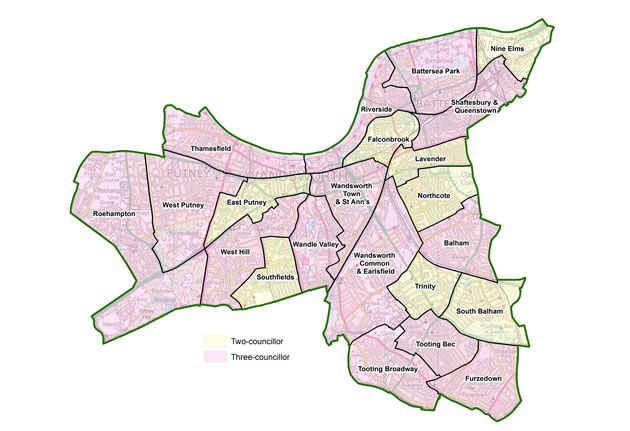Radical Changes Proposed for Wandsworth Ward Boundaries
New homes in Nine Elms and Battersea requires reorganisation

Proposed ward changes for Wandsworth. Picture: Boundary Commission
October 29, 2019
Wandsworth could see fewer councillors and more wards created in new proposals released by the independent Local Government Boundary Commission for England.
With Nine Elms and Battersea Power Station creating thousands of more homes in the north of Wandsworth, the density of the borough is beginning to change
Wandsworth currently has 60 councillors across 20 wards, which would change to 58 councillors across 22 wards if the plans are accepted.
The council has not been reviewed since 1999. The recommendations outline how those councillors should represent 14 three-councillor wards, and 8 two-councillor wards across the council.
There are key changes to the north-east of the borough near Battersea and the new Nine Elms development.
Currently this all comes under Queenstown ward, which has three councillors. However, the new plans would roughly split this into three new wards – Battersesa Park, Nine Elms and part of Shaftesbury and Queenstown.
To reflect the density of this part of the borough, both Battersea Park and Shaftesbury and Queenstown would have three councillors each, while the smaller Nine Elms would have two.
The new plans aim to ensure each councillor represents roughly the same number of electors as others across the council.
Some wards in other parts of the borough such as Southfields have been made smaller, and will have two councillors, for example.
A public consultation launches this Tuesday (October 29) and will last until January 13 2020.
It is open to anyone who wants to have their say on the new wards, boundaries and even ward names across the borough.
Riverside, Lavender, Falconbrook, Tooting Broadway and Tooting Bec have all been proposed as new ward names with slightly different boundaries that are easier for residents to understand.
The full recommendations and detailed interactive maps are available on the Commission’s website at consultation.lgbce.org.uk and www.lgbce.org.uk that allow you to go down to street level to see exactly where the new wards cut off.
Hard copies of the Commission’s report and maps will also be available to view at council buildings.
Professor Colin Mellors, Chair of the Commission, said: “We are publishing proposals for a new pattern of wards across Wandsworth and we are keen to hear what local people think of the recommendations.
“Over the next 10 weeks, we are asking local people to tell us if they agree with the proposals or if not, how they can be improved.
“Our review aims to deliver electoral equality for local voters. This means that each councillor represents a similar number of people, so that everyone’s vote in council elections is worth roughly the same, regardless of where you live.
“We also want to ensure that our proposals reflect the interests and identities of local communities across Wandsworth and that the pattern of wards can help the council deliver effective local government for local people.
“We will consider all the submissions we receive, whoever they are from and whether your evidence applies to the whole council or just a part of it.”
Leaders at the council have welcomed the report and encourage the public to take part in the consultation to have their say over local democracy.
After the consultation the Commission will publish its final recommendations in March 2022.
They are due to come into effect at the next London elections in 2022, subject to parliamentary scrutiny.
To submit your views visit the online portal, email reviews@lgbce.org.uk or write to:
The Review Officer (Wandsworth)
Local Government Boundary Commission for England
1st Floor, Windsor House
50 Victoria Street
London SW1H 0TL